The largest weapon of World War I, the Paris Gun, also known as the Kaiser Wilhelm Gun, was used by the Germans to attack the French capital in 1918.
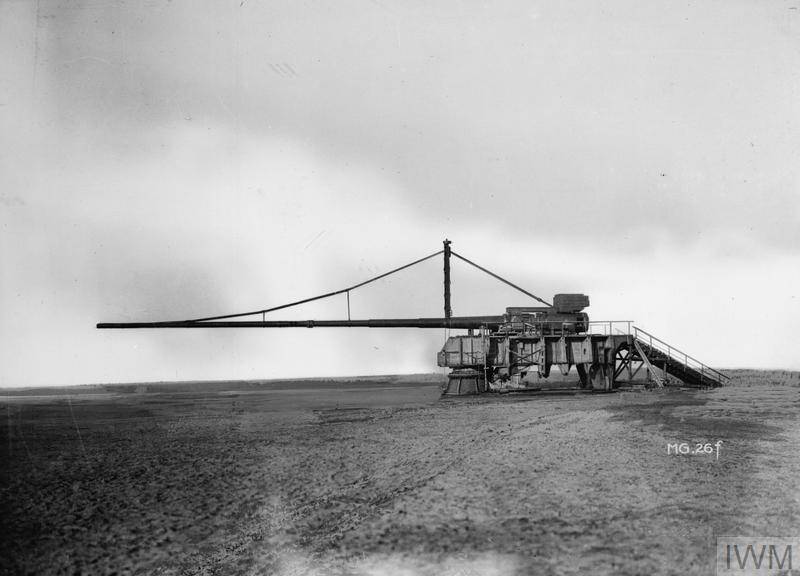
Imperial War MuseumThe Paris Gun, World War I’s largest gun.
The Paris Gun, one of World War I’s most formidable and terrifying weapons, was a giant artillery piece that reached unimaginable distances and heights, striking fear into the heart of Parisians.
Utilized by Germany against France in 1918, the Paris Gun measured over 111 feet long and weighed 256 tons. Its impressive capabilities allowed it to fire a 234-pound shell 81 miles, reaching an altitude of 26 miles — a feat that remained unmatched until the creation of the V2 rocket in 1942.
Between March and August 1918, the Paris Gun fired between 320 and 367 shells projectiles into the city of Paris, killing 250 people and striking fear into the heart of the city. However, the use of the Paris Gun was short-lived. With the Allied forces advancing into northern France, it was ultimately dismantled by the Germans.
Though it didn’t change the course of the Great War, the Paris Gun left a lasting legacy. During World War II, it inspired the German military to develop other — even larger — guns.
Germany Prepares For World War I
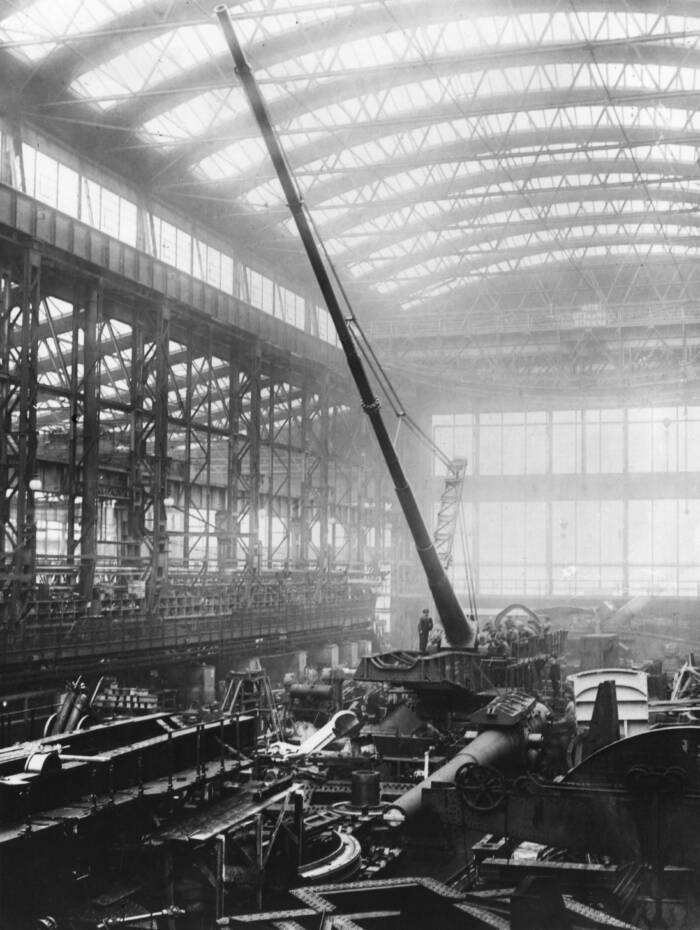
Chronicle / Alamy Stock PhotoThe Paris Gun under construction in the Krupp factory.
Following the 1914 assassination of Austro-Hungarian Archduke Franz Ferdinand by Bosnian Serb Gavrilo Princip, the nations of Europe slid into World War I.
On August 1, 1914, Germany joined the Great War after its ally, Austria-Hungary, declared war on Serbia. Following a series of failed neutrality demands from France and Russia, Serbia’s allies, Germany developed the Schlieffen Plan to attack France, Russia, and Belgium.
On August 4, German troops invaded Belgium, sparking the involvement of Britain, which had a treaty with Belgium. The German offensive was initially a success, but French resistance outside of Paris created a stalemate between the two forces. Difficulties for the Germans only increased when forces led by Australia, Britain, and Japan seized its Pacific territories.
Following a particularly painful British naval blockade of the country, Germany began resorting to unrestricted submarine warfare, eventually inciting the ire of the United States – especially after German U-boats sunk the RMS Lusitania, a passenger ship carrying 159 Americans.
By 1918, Germany was in a tough position. The battle for France had devolved into hellish trench warfare, and German demands for a peace agreement had been rejected by the Allies.
Germany needed any advantage it could get, and that came in the form of an 100-foot long gun called the “Kaiser Wilhelm Gun” — which would soon become known as the Paris Gun.
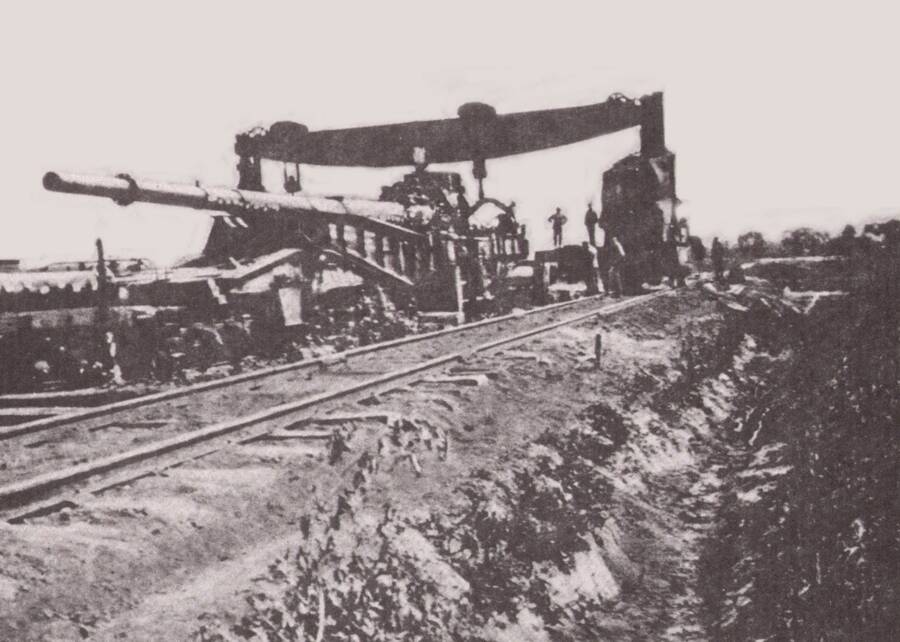
Public DomainThe Paris Gun prepared for rail transport.
First created in 1918 by Krupp, Germany’s premier weapons manufacturer, the Paris Gun was a formidable piece of artillery — and one of World War I’s most intimidating weapons.
The Impressive Capabilities Of The Paris Gun
Construction of the monstrous Kaiser Wilhelm Gun began in 1918. With Paris still out of Germany’s grasp, the Germans needed a new device that would restore hopes for victory. In came the Paris Gun.
The gun measured over 111 feet long and weighed 256 tons. Its long barrel was capable of shooting a 234 pound shell up to 81 miles away and reaching a maximum altitude of 26 miles at a speed of almost 4,000 miles per hour. The Paris Gun set the record for greatest height achieved by a man-made projectile until the creation of the V2 rocket in World War II.
Indeed, the altitude of the Paris Gun shells was so high that engineers needed to considered the rotation of the Earth when performing calculations to hit intended targets.
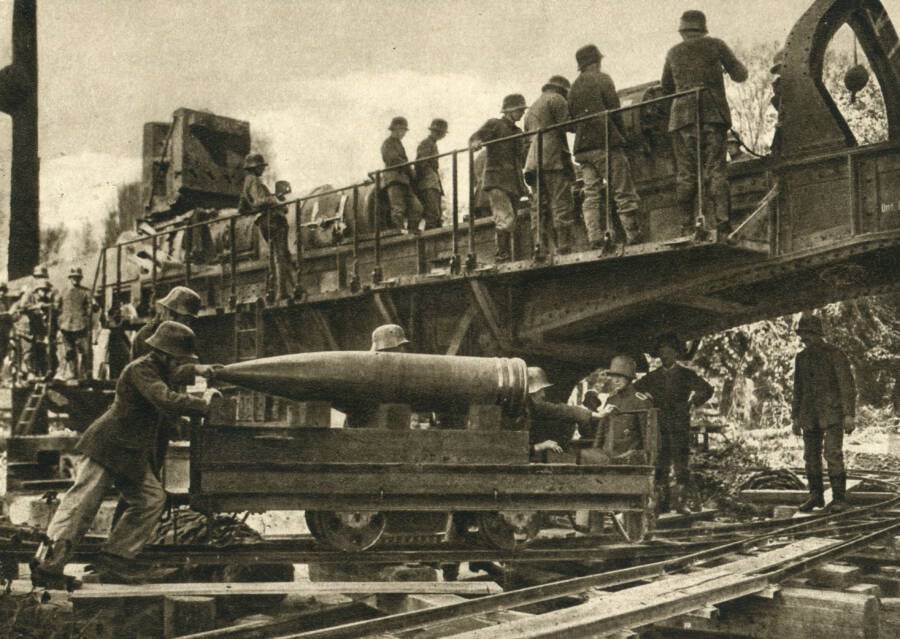
Shotshop GmbH / Alamy Stock PhotoSoldiers loading a Paris Gun with a shell.
The guns were transported from Germany to a site within firing range of Paris via rail, and were flanked by standard artillery to create a sound shield to prevent Allied forces from locating the guns when they fired. They were installed near near Crépy, France, roughly 75 miles from Paris, Bois-de-Corbie, 68 miles from Paris, and Bois-des Bruyeres, 56 miles from Paris.
The first Paris Gun was fired from Crépy on March 21, 1918. With 80 German soldiers manning the weapons, the guns fired 21 projectiles on Quai de la Seine in Paris, killing 15 people and wounding 36 others. One crater left by the projectiles measured 10 feet across and four feet deep.
The shots fired at 15 minute intervals, causing panic among Parisians. Many attempted to flee the city, believing that the explosions were the result of bombs dropped from undetectable airplanes or zeppelins.
It was “as though some strange visitation from the planet Mars, bringing death in its pathway, had suddenly intruded upon the streets of the city,” the American ambassador, William Graves Sharp recalled. “[The shells] simply dropped from space like some hugh meteorite.”
Six Months Of Terror For Paris
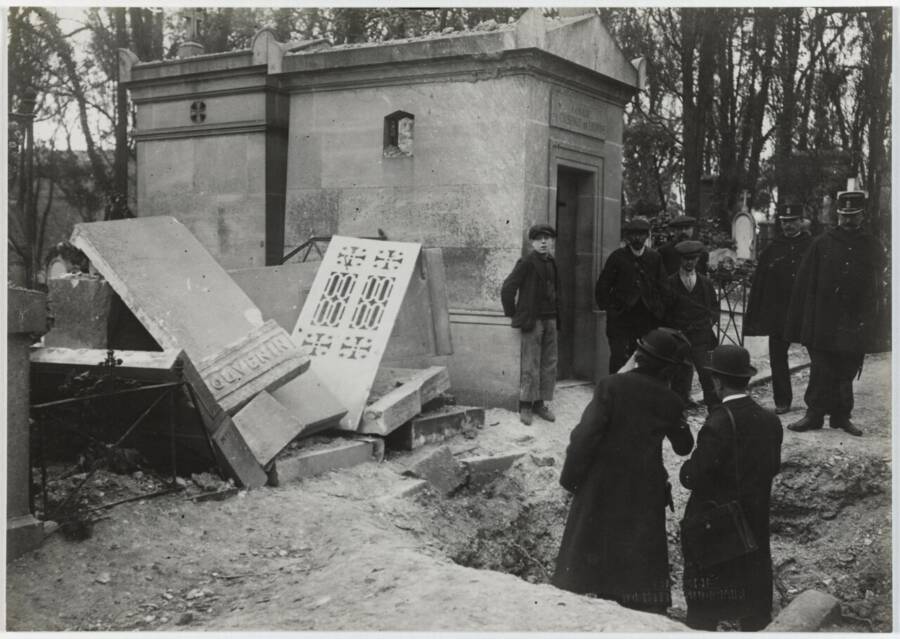
Public DomainDamage from a Paris Gun shell in the Père Lachaise Cemetery on March 25, 1918.
The Paris Gun continued firing in bursts for six terrifying months. In total, between 320 and 367 projectiles were fired from the Paris Gun, ultimately killing 256 people and wounding 625.
The most fatal day took place on March 29, when a projectile landed on Saint-Gervais-Saint-Protais Church during a service, killing nearly 100 people, including several members of European nobility. French writer Romain Rolland, who lived in Paris during the bombardment, recounted this event in his fictional love story Pierre and Luce:
“At the same instant the great pier against which they leaned their backs moved, and down to its very base the entire church trembled,” Rolland wrote, “And Luce, whose heart beats deadened in her the crash of the explosion and the shrieks of the crowd, threw herself upon Pierre… and the massive pier crumbled down upon them with one crash.”
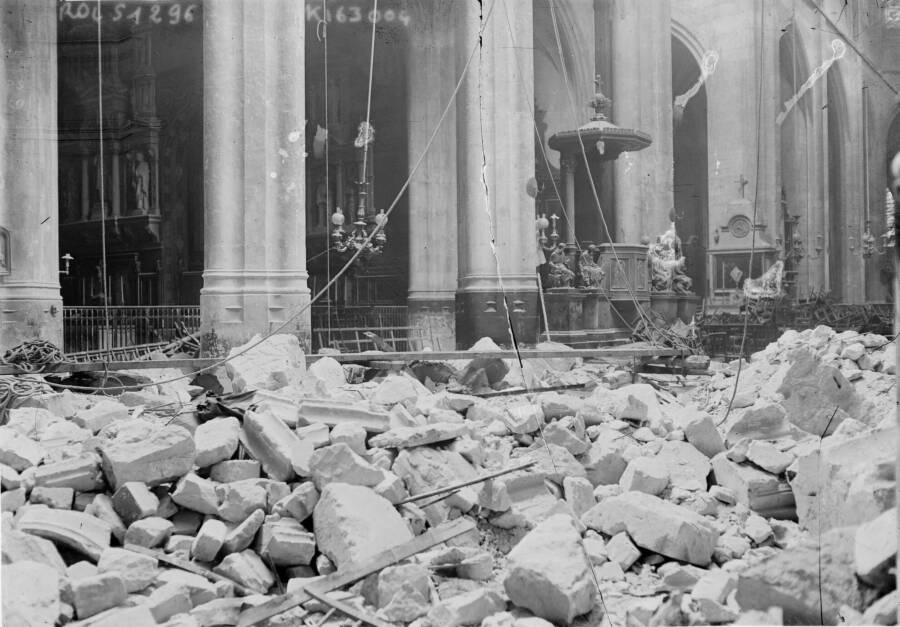
Public Domain The aftermath of the shelling on Saint-Gervais-Saint-Protais church.
However, the Paris Gun’s torment on the city of Paris was short lived, with its last shot occurring on August 9.
And while the Paris Gun was impressive, it did have its downsides. Its payload was small and the force of its shots required the barrel to be replaced frequently. What’s more, the gun was largely inaccurate.
These issues, coupled with Allied advancement into northern France, led to the Paris Gun being shipped back to Germany. There, the guns and their construction plans were seemingly destroyed. Although Germany was instructed to turn over a Paris Gun at the end of the war, they refused.
Still, the Paris Gun left behind a gargantuan legacy.
Is The Paris Gun The Largest Gun In History?
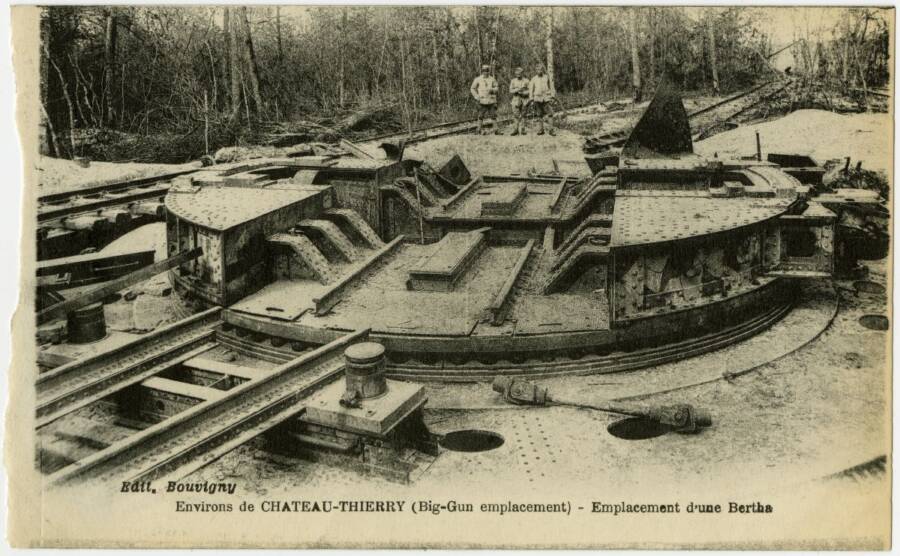
Public DomainA Paris Gun turntable mounting photographed by U.S. forces near Château-Thierry, c. 1918.
While the Paris Gun is the largest gun of World War I, it is not the largest gun ever created. That award goes to the Schwerer Gustav, a German gun created for battle during World War II.
Also created by Krupp, the Schwerer Gustav weighed over 1,300 tons and could fire seven ton shells over 29 miles away. It was created in secrecy to destroy fortifications along the Maginot Line in France and, although it never saw combat in France, the gun devastated the city of Sevastopol during an eight month siege. To this day, it remains the heaviest mobile artillery weapon ever used in combat.
The Paris Gun undoubtedly influenced the creation of the Schwerer Gustav. And it’s not all that it inspired. In the 1930s, German engineers began working on ideas for a large artillery gun similar to the Paris Gun. They couldn’t simply recreate the Paris Gun, as the Treaty of Versailles explicitly banned its creation and use.
With permission from the newly elected Nazi party, Germany engineers thus re-tuned designs from the Paris Gun and created the K 12 railway gun, a 300 ton artillery gun capable of firing shells up to 71 miles away. During the war, the K 12 guns were installed along the English Channel.
Both the K 12 and the Schwerer Gustav built upon the legacy of the Paris Gun, mirroring its ability to instill fear. As such, though no living example of the Paris Gun exists today, the largest gun of WWI left behind a huge impact.
After reading about the Paris Gun, dive into 23 crazy weapons invested by the Nazis. Then, read about Tsar Bomba, the biggest nuclear bomb ever made.





